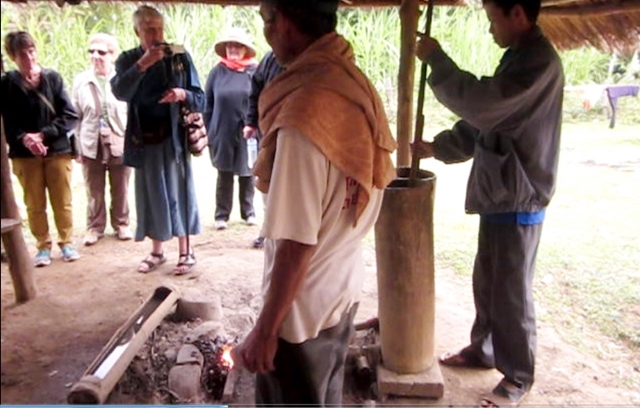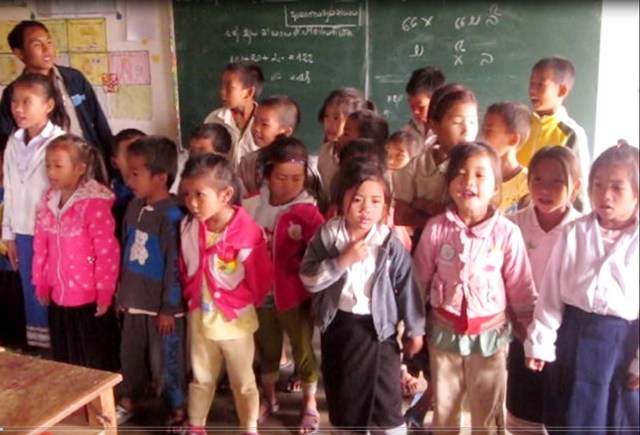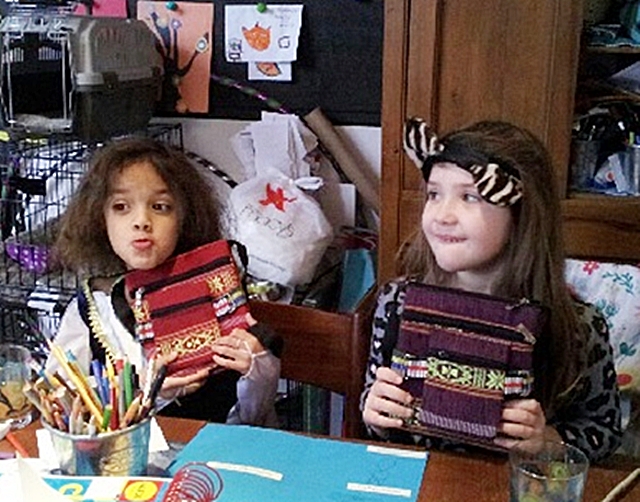Southeast Asia with Peter – Day 6
Today is a special day. It includes an early morning of alms giving with the monks and a “Day in the life” with a local village.

 We arose at 4:30 and Tuk Tuked to dark street in Luang Prabang. We took our shoes off, put on a neck scarf , sat on little (for me) seats on a mat facing bamboo baskets containing cooked “Sticky Rice” and waited. That’s Mary Fountain from CA, Will, myself, and Joyce.
We arose at 4:30 and Tuk Tuked to dark street in Luang Prabang. We took our shoes off, put on a neck scarf , sat on little (for me) seats on a mat facing bamboo baskets containing cooked “Sticky Rice” and waited. That’s Mary Fountain from CA, Will, myself, and Joyce.


 Sometime before sunrise we heard a series of dull BONGS off in the distance. That was the signal for the daily procession by the 250+/- monks from the many temple in Luang Parang to collect rice from the villagers for the day. I wasn’t able to get good shots of us actually putting small rice balls in each pot so I shot pictures of others doing it in front of a temple instead. As I said: This is a daily occurrence. There was even a little beggar boy along the route. Perhaps he was looking for a handout, too.
Sometime before sunrise we heard a series of dull BONGS off in the distance. That was the signal for the daily procession by the 250+/- monks from the many temple in Luang Parang to collect rice from the villagers for the day. I wasn’t able to get good shots of us actually putting small rice balls in each pot so I shot pictures of others doing it in front of a temple instead. As I said: This is a daily occurrence. There was even a little beggar boy along the route. Perhaps he was looking for a handout, too.
One note about the monks: Most rural families send sons to the monasteries for schooling. This gives the boys some education and shows respect for the parents. There are public schools, but they cost a lot, so monasteries are a better choice for many. Rural girls generally get little or no formal education unless it’s at a private ($$) school. These are very general statements and do not reflect all Laotian education.
After feeding the monks, we we’re each given an item to buy in the “Morning Market”. Each of us had an item written in phonetic Laotian. Peter and I set out together. Here are some of the foods for sale in the market. Most people do not have refrigerators and buy food day-to-day.
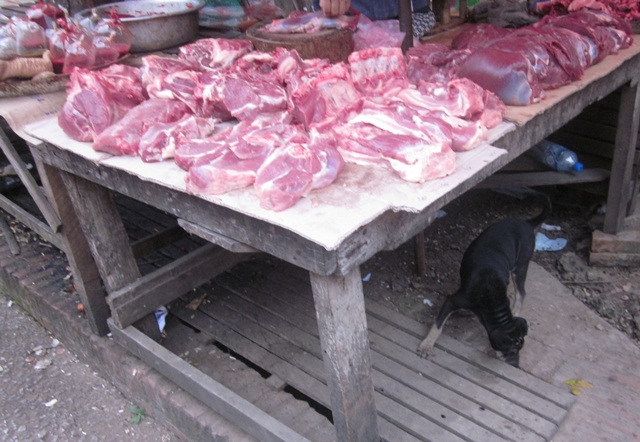






 Of special interest were the little cooked pastries shown here. They were cooked in two parts and put together into a ball and served in a little cup made from a banana leaf (on the left). They were sweet and tasty and made a nice morning snack Note the cooker: It was a standard item everywhere. A cement “bucket” that was fueled from an opening on one side and had 3 prongs to hold up a wok.
Of special interest were the little cooked pastries shown here. They were cooked in two parts and put together into a ball and served in a little cup made from a banana leaf (on the left). They were sweet and tasty and made a nice morning snack Note the cooker: It was a standard item everywhere. A cement “bucket” that was fueled from an opening on one side and had 3 prongs to hold up a wok.
It turned out that our item was a jug of cooking oil. I came into use later when we cooked part of our own lunch. Other folks bought other ingredients. We then returned to the Grand Hotel for breakfast.
Our next event was quite a ways out of town. We took our bus to the Laotian village of Thin Keow. It was about an hours ride up narrow rural roads past teak plantations and small farms and fields.
 We first met the village blacksmith. He demonstrated his bellows made from 2 bamboo tubes that were pumped up and down to heat up his coals. He then began hammering on a piece of a truck leaf spring to fashion an ax head. You can see a piece of the spring on the ground in front of him. We were told that his anvil was an old artillery shell casing. I’m not sure about that.
We first met the village blacksmith. He demonstrated his bellows made from 2 bamboo tubes that were pumped up and down to heat up his coals. He then began hammering on a piece of a truck leaf spring to fashion an ax head. You can see a piece of the spring on the ground in front of him. We were told that his anvil was an old artillery shell casing. I’m not sure about that.
 We next sampled a bit of barbecued rat. It tasted a bit like chicken. The little white area is where we broke off pieces (small). Of course, Pete had to try it. So did Will and I.
We next sampled a bit of barbecued rat. It tasted a bit like chicken. The little white area is where we broke off pieces (small). Of course, Pete had to try it. So did Will and I.
 The cook showed us how he caught mice with a spring loaded trap. He had a barbecued bat on the skewer in his left hand. We were told that Laotians would eat almost anything. (I wonder where they draw the line?)
The cook showed us how he caught mice with a spring loaded trap. He had a barbecued bat on the skewer in his left hand. We were told that Laotians would eat almost anything. (I wonder where they draw the line?)
 He also showed us his bird trap baited with a little grub. Look out PETA!
He also showed us his bird trap baited with a little grub. Look out PETA!

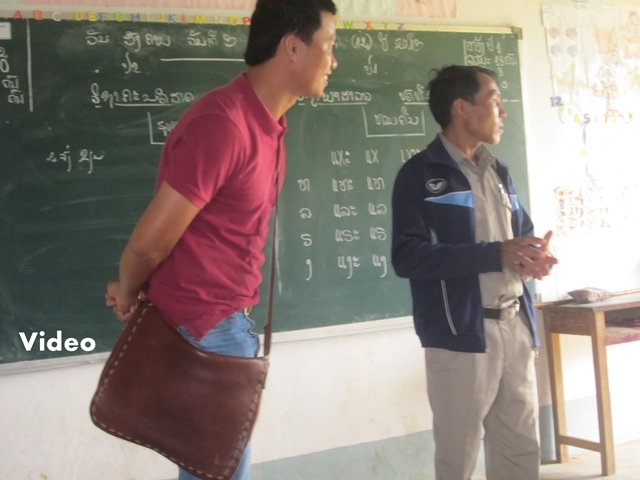 We then visited the local school. This is partially funded by the Grand Circle Foundationn from donations made by OAT and GCT people. The kids sang the Laotian National Anthem (I think); We sang a song to them and then gave them gifts.
We then visited the local school. This is partially funded by the Grand Circle Foundationn from donations made by OAT and GCT people. The kids sang the Laotian National Anthem (I think); We sang a song to them and then gave them gifts.
I brought a big bunch of “Little Golden Books” from home. They were a big hit!! The kid with the red sweat shirt (above)grabbed a book and yelled “MEEKY MOUSE!” and quietly slipped it into his school bag. Dao introduced their teacher who answered a lot of our questions.
 We then left the school and walked across the soccer field to an adjoining Hmong Village. That’s “Dammit Janet” on the seesaw.
We then left the school and walked across the soccer field to an adjoining Hmong Village. That’s “Dammit Janet” on the seesaw.
 This is the Hnomg village. Most of the people were away working in the fields.
This is the Hnomg village. Most of the people were away working in the fields.
Here is a bit of Hmong history: The Hmong are an Asian ethnic group from the mountainous regions of China, Vietnam, Laos, and Thailand. Hmong groups began a gradual southward migration in the 18th century due to political unrest and to find more arable land. Hmong people are known to be fiercely independent and rich in their culture, art, religion, family life and martial history (polygamy), and are distinguished by costumes and dress (fabric patterns represent fruit, vegetables, farming, chickens, eggs, etc.)
During the American War (aka Vietnam War) the United States government recruited thousands of Hmong people in Laos to fight against invading military forces from North Vietnam and communist Pathet Lao insurgents, known as the Secret War. During the Vietnam War and the Laotian Civil War, Hmong people were singled out for retribution by the Khmer Rouge and Vietnamese Army when they took over the Laotian government from them in 1975. Hundreds of thousands of Hmong refugees fled to Thailand seeking political asylum. Thousands of these refugees have resettled in Western countries since the late 1970s, mostly the United States. Others have returned to Laos under United Nations-sponsored repatriation programs.

 This is a typical Hmong home. The siding is split bamboo flattened into “planks” with a roof made from palm fronds. The interior is spartan: Dirt floor, cooking fire in the center, and beds and possessions on raised platforms around the outside walls. Cooking smoke goes out through cracks in the roof and walls.
This is a typical Hmong home. The siding is split bamboo flattened into “planks” with a roof made from palm fronds. The interior is spartan: Dirt floor, cooking fire in the center, and beds and possessions on raised platforms around the outside walls. Cooking smoke goes out through cracks in the roof and walls.
 We met this Hmong farmer and his newly wed wife. This is first wife. If he is prosperous, he may have others. Through Dao (our Laotian guide) the farmer told us about his farm and home. He spoke with mature confidence. His wife was dressed in a festive outfit for our visit. She was a lovely young women – very poised!
We met this Hmong farmer and his newly wed wife. This is first wife. If he is prosperous, he may have others. Through Dao (our Laotian guide) the farmer told us about his farm and home. He spoke with mature confidence. His wife was dressed in a festive outfit for our visit. She was a lovely young women – very poised!

 At the edge of the village our bride and other Hmong ladies were selling their (?) handicraft. I missed buying that colorful embroidery hanging of the left side of the top picture by $2.00 (it was bought for $35.00 by Mary). So much for haggling. I did buy a small piece of fabric with a hand stitched “curly-cue” . Mary Ann and her quilting group were impresses with the tiny stitches.
At the edge of the village our bride and other Hmong ladies were selling their (?) handicraft. I missed buying that colorful embroidery hanging of the left side of the top picture by $2.00 (it was bought for $35.00 by Mary). So much for haggling. I did buy a small piece of fabric with a hand stitched “curly-cue” . Mary Ann and her quilting group were impresses with the tiny stitches.
 This embroidered piece displays the daily activities in a Hmong village, The Hmong are shown on their way to or from farms. In the upper left, a man is feeding chickens. Hmong raised domestic animals for food consumption and for special occasions like wedding and ritual sacrifices. At left center, a man and woman are using a mill stone to grind maize (corn) and rice to feed their animals, as well as to make cakes and noodles. On the bottom is a scene depicting women tending their garden. Very colorful, indeed!!
This embroidered piece displays the daily activities in a Hmong village, The Hmong are shown on their way to or from farms. In the upper left, a man is feeding chickens. Hmong raised domestic animals for food consumption and for special occasions like wedding and ritual sacrifices. At left center, a man and woman are using a mill stone to grind maize (corn) and rice to feed their animals, as well as to make cakes and noodles. On the bottom is a scene depicting women tending their garden. Very colorful, indeed!!
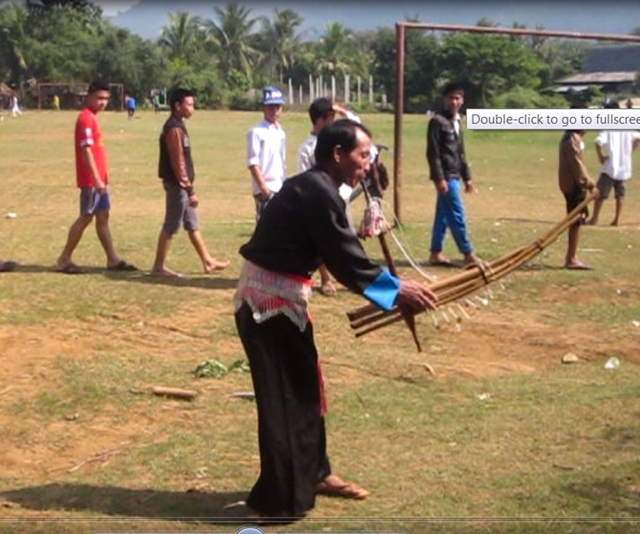 While looking at the Hmong handicrafts, we were serenaded by a Hmong musician playing a Khaen and dancing. The Khaen made a low moaning sound sort of like the low notes on a bagpipe. His dance was whirling and jumping. He acted a bit dizzy and I thought he’d fall, but he didn’t. The Hmong village was adjacent to the Laotian village soccer field and some Laotion boys stopped for a moment to watch. There was quite a contrast between the Laotians and Hmong villagers!
While looking at the Hmong handicrafts, we were serenaded by a Hmong musician playing a Khaen and dancing. The Khaen made a low moaning sound sort of like the low notes on a bagpipe. His dance was whirling and jumping. He acted a bit dizzy and I thought he’d fall, but he didn’t. The Hmong village was adjacent to the Laotian village soccer field and some Laotion boys stopped for a moment to watch. There was quite a contrast between the Laotians and Hmong villagers!
 After visiting the Hmong village, we returned to the Laotian village (across the soccer field) and went to the home of Chan Peng – the ex-Village Chief – for lunch. Our contribution was a stir fried rice noodle and sweet basil dish made from ingredients purchased earlier in the day at the Luang Prabang “morning market”.
After visiting the Hmong village, we returned to the Laotian village (across the soccer field) and went to the home of Chan Peng – the ex-Village Chief – for lunch. Our contribution was a stir fried rice noodle and sweet basil dish made from ingredients purchased earlier in the day at the Luang Prabang “morning market”.
 Chef Peter officiated at the wok with Sous-Chef Dao assisting, The secret ingredient was crushed rice cakes added at the end. It was a tasty dish with a nice crunch. We also had several other delicious dishes prepared by the ex-Chief’s wife. Note the ball caps: Pete swapped a “Brewster Oyster” Cap for a “1939” cap (his birth year).
Chef Peter officiated at the wok with Sous-Chef Dao assisting, The secret ingredient was crushed rice cakes added at the end. It was a tasty dish with a nice crunch. We also had several other delicious dishes prepared by the ex-Chief’s wife. Note the ball caps: Pete swapped a “Brewster Oyster” Cap for a “1939” cap (his birth year).
 After a nice lunch – the “happy room” beckoned…
After a nice lunch – the “happy room” beckoned…
We left Thin Keow village and drove to the Kuang Si Falls:

 Don’t ask me why there was an Asian Black Bear exhibit there, but there it was! Note the distinctive white “bib”. The Asian black bear also known as the moon bear or white-chested bear, is a medium-sized species of bear, largely adapted for arboreal life, seen across much of the Himalayas and the northern parts of the Indian Subcontinent, Taiwan, Korea, northeastern China, the Russian far east and the Honshū and Shikoku islands of Japan. It is classed as a vulnerable species, mostly due to deforestation and active hunting for its body parts.
Don’t ask me why there was an Asian Black Bear exhibit there, but there it was! Note the distinctive white “bib”. The Asian black bear also known as the moon bear or white-chested bear, is a medium-sized species of bear, largely adapted for arboreal life, seen across much of the Himalayas and the northern parts of the Indian Subcontinent, Taiwan, Korea, northeastern China, the Russian far east and the Honshū and Shikoku islands of Japan. It is classed as a vulnerable species, mostly due to deforestation and active hunting for its body parts.

 Here are the falls and the only two intrepid adventurers in our group. Pay no attention to the nymphet on the left. Will took this picture. Alas, she was not part of our group…
Here are the falls and the only two intrepid adventurers in our group. Pay no attention to the nymphet on the left. Will took this picture. Alas, she was not part of our group…
 ‘Nuff said?? As we stood in the cloudy water, there were lots of little unseen fishes nibbling at our feet. We’ll learn more about this phenomenon later.
‘Nuff said?? As we stood in the cloudy water, there were lots of little unseen fishes nibbling at our feet. We’ll learn more about this phenomenon later.
We returned to town and had “Dinner on our own” (read: OAT doesn’t pay). Will, Mary, Pete, Gloria, and I had burgers and fries at a local restaurant and went off to visit the night market (again). I bought these 2 purses for my grand daughters (Zoe and Saoirse) back in the US. They got them at Christmas.
So ended Day 6 of our overseas adventure.

